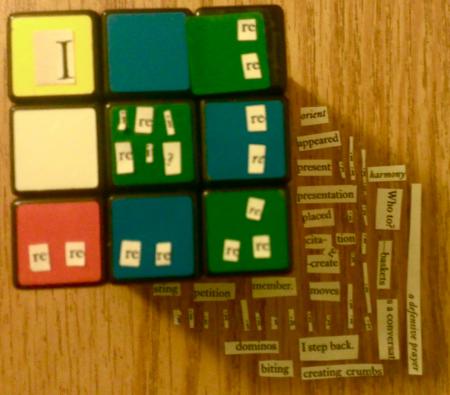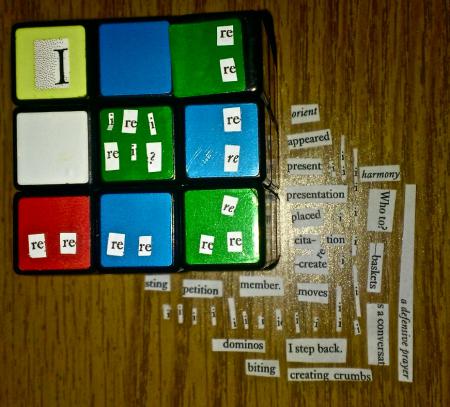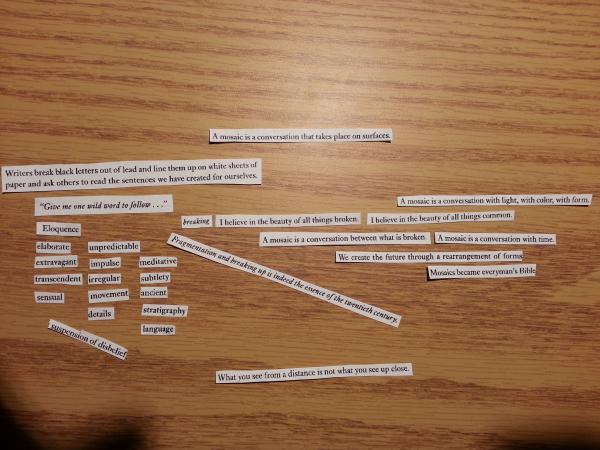Serendip is an independent site partnering with faculty at multiple colleges and universities around the world. Happy exploring!
Blogs

IMosaic (without flash)
If I turned on flash, then I lost the shadow of the rubik's cube. If I did not turn it on, the words were blurry. So, I'm posting two pictures one with flash and one without!


Evaluating Multimodal Texts
Facing declining retention rates and dropping grades, many universities are looking for new ways to increase student engagement and, as a result, educational outcomes. Ball State University's Institute for Digital Education and Entertainment, in an attempt to develop tools that would engage students and teachers in a way that took advantage of web-based technology, turned to multimodal learning strategies.
Ball State came up with a resource called Vizi, an online-based platform that uses multiple forms of media, integrated into targeted courseware that is flexible and engaging. While Vizi is an interesting platform in and of itself, Ball State's research and analysis of Vizi's results are what's really interesting: the designers behind Vizi wanted to use multiple channels to simultaneously engage many parts of the learner's brain. Part of their design was to create sections and sub-sections whose objectives students had to meet to move on, and to assess their understanding. They also attempted to integrate both linear and nonlinear paths.

Ideas about Persepolis
Since I was not present in class today I wanted to share some interesting aspects of the book I found while reading. This book describes an intense time in our world's history and is able to depict a wide range of emotions very accurately using only black and white childlike drawings. Because this story is being told by a child I think it is appropriate since we are seeing this story unfold from a child's perspective. The idea of black and white drawings is also interesting because during this time many people saw others as either good or bad; on their side or on the 'other' side. This stark contrast demonstrates the mentality of the time and is definetly appropriate.
One more point I thought was interesting was the difference between what the words said and what the pictures protrayed. I know Anne told us to watch for that difference and I found one particularly interesting one on page 43 when they are talking about the Shah fleein the country and the girl's father says, "Let's talk about something else. Let's enjoy our new freedom." Then her mother says, "Now that the devil is gone." The picture protrays the devil curled around the family with his tail hanging directly above the mother. This is obviously foreshadowing what is to come and it brings the idea that one cannot see all of the dangers lurking.

SRI International: Enhancing Student Success in Online Learning
The question on the mind of the educator, blended learning enthusiast or otherwise, when faced with online courses is always the same: as EdSurge asks, "Do online courses work?" Supporters and detractors alike have been attempting to answer this question for years, citing mixed anecdotal result and conflicting research. Now, SRI International is attempting to provide closure to at least one part of the question by extensively reviewing online Alegrba 1 courses in a report called "Supporting K-12 Students in Online Learning: A Review of Online Algebra 1 Courses." The report, which is the first phase of a larger study, examines six online course providers and profile their strengths and weaknesses. Algebra 1 is slightly outside the purview of most college-level educators, but the report doesn't stop with reviewing these courses. The study is focused on three research questions:
9-15 NYT artice on Minecraft: Obsession and Ed Tool!
http://bits.blogs.nytimes.com/2013/09/15/minecraft-an-obsession-and-an-educational-tool/?smid=fb-share&_r=1&

Increase Grading Efficiency with a Comment Archive
In their collection of teaching strategies for higher education, Faculty Focus includes an article suggesting strategies to increase the efficiency of grading. Specifically, they address how to improve the efficiency of computerized (as opposed to analog, pen-and-paper) grading using what the article calls a “comment archive.” The article discusses strategies for taking advantage of the options built into your basic word processor to increase the speed and ease of your grading without sacrificing the quality of your comments. The most user friendly and simple option involves building your frequently used comments into the AutoCorrect feature of, for example, Microsoft Word. Then, instead of typing and retyping a comment each time you use it, simply use the shortcut you designated. The article includes step-by-step instructions and a video tutorial.







